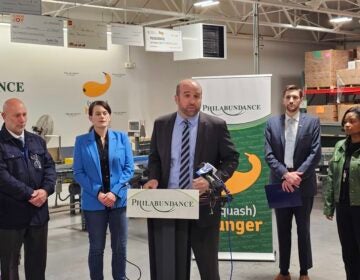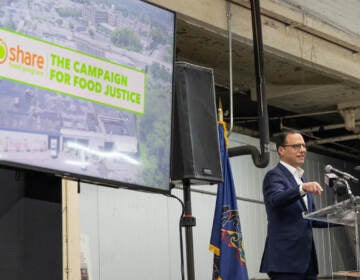Hunger declines, but some fear Trump proposals could reverse the trend
According to the research, 11.1% of U.S. households — about 14 million — were food insecure in 2018, down from 11.8% in 2017.

People queue up during a food giveaway at Dobbins High School in North Philadelphia this summer. (Avi Steinhardt/The Philadelphia Inquirer)
A newly released federal report shows that the number of Americans experiencing hunger decreased from about 40 million in 2017 to 37.2 million in 2018, the fewest since prior to the Great Recession.
The U.S. Department of Agriculture report measures household food insecurity, defined as a lack of enough food during the year to foster active, healthy living for a family.
According to the research, 11.1% of U.S. households — about 14 million — were food insecure in 2018, down from 11.8% in 2017.
The improved economy is considered a significant reason for the change, anti-hunger advocates say. Food stamps, also, play a vital role, advocates add since the benefit goes a long way toward keeping families from falling into hunger. The decrease in food insecurity occurred during President Donald Trump’s time in office, yet anti-hunger advocates hasten to say that Trump may well undo gains against hunger with his administration’s efforts to cut food-stamp benefits.
Overall, experts are encouraged by the drop in hunger, but not ecstatic.
“I think it’s good news,” said Jim Weill, president of the Food Research & Action Center (FRAC), an anti-hunger lobby in Washington. “But more work needs to be done.”
Indeed, it would be short-sighted to celebrate any report that shows more than 37 million Americans still struggle with hunger, said Joel Berg, CEO of Hunger Free America, based in New York.
“Less hunger is better, but we’re still talking about a number of hungry people equal to the combined populations of Ohio, Georgia, and the five states of New England,” he said. “One in seven children still lacks sufficient food. And Trump cuts would make a horrid situation even more horrid.
“Hunger may be down, but this is still a huge, huge red flag.”
Berg added that the number described as hungry in 2018 was still greater than the 36.2 million Americans who were food insecure in 2007, before the recession.
The Trump administration’s ongoing plans to cut food stamps, Berg added, could result in 3.1 million Americans losing their benefits, including 200,000 Pennsylvanians and 250,000 New Jersey residents.
In Pennsylvania, household food insecurity in 2018 was 11.1%, the same as the national number, and a decline from 12.4% in 2015. In New Jersey, it was 8.5%, down from 11.1% in 2015.
The USDA did not calculate city-level numbers.
However, the latest data from Chicago-based Feeding America, the nation’s largest anti-hunger charity, showed that household food insecurity in Philadelphia is about 20%.
Despite that high number, research from Philabundance, the largest local hunger-relief agency and a member of Feeding America, demonstrates a fall in food insecurity in the area: In 2017, there were 683,020 food-insecure people in the Philabundance service area, down from 717,380 in 2016, according to the latest available numbers. The agency’s service area includes Philadelphia and the four surrounding Pennsylvania suburban counties, as well as Burlington, Camden, Gloucester, and Salem Counties in New Jersey.
Glenn Bergman, executive director of Philabundance, pointed out that the new USDA report delineates families with children, as well as African Americans (at 21.2% food insecurity rates), Hispanics (16.2%), and those living in rural areas and the South as having to “continue to disproportionately struggle to put food on the table.”
Bergman was highly critical of Trump administration plans to slash food stamps, known as SNAP benefits (for Supplemental Nutrition Assistance Program).
“Now is the time to support nutrition programs, not make cuts,” he said. “Policies that cut people off of nutrition programs will only increase hunger and poverty.”
Weill of FRAC agreed: “We need jobs, wage growth, and strong nutrition programs, which this administration is certainly eroding.”
Trump has said the $68 billion SNAP program is too costly. Hunger fighters say it provides a minimal benefit while preventing starvation.
 WHYY is one of over 20 news organizations producing Broke in Philly, a collaborative reporting project on solutions to poverty and the city’s push towards economic justice. Follow us at @BrokeInPhilly.
WHYY is one of over 20 news organizations producing Broke in Philly, a collaborative reporting project on solutions to poverty and the city’s push towards economic justice. Follow us at @BrokeInPhilly.
WHYY is your source for fact-based, in-depth journalism and information. As a nonprofit organization, we rely on financial support from readers like you. Please give today.




